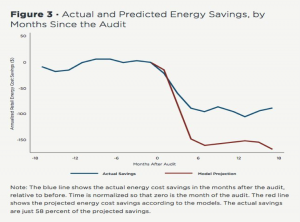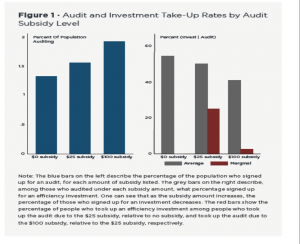A study found that the cost of former President Obama’s residential audit program exceeded the value of the energy savings and the environmental benefits. The computer models projected that the subsidies provided to homeowners would save far more money than they actually realized. The realized savings were only 58 percent of what the computer models predicted. (The efficiency rules were projected to save 2.5 times more financial value than they actually realized.) Further, they generated only $0.20 in environmental benefits per subsidy dollar spent. The study concluded that when all the benefits had been calculated, the auditing program had a negative rate of return of about 4 percent.[i] The Obama Administration’s home audit program, managed by the Department of Energy, was created as part of the 2009 stimulus bill.
Source: Haas School of Business
As the Trump Administration evaluates efficiency measures of the Obama Administration, it should keep this study in mind.
The Study
The study was conducted by researchers from the Massachusetts Institute of Technology, the University of Chicago, and the University of California, Berkeley. They conducted a randomized experiment of over 100,000 households in Wisconsin from June 2012 to February 2013 to evaluate two federally-funded residential energy efficiency programs—the Green Madison and the Milwaukee Energy Efficiency programs. The programs were funded with grants of $2.4 million and $732,000, respectively. The grants subsidized home audits educating homeowners about steps they could take to improve efficiency. An Energy Advocate was also provided to help homeowners understand and implement the audit results. Further, some of the energy efficiency investments were also subsidized.
There were two groups of home owners—those receiving information and a control group.
The study’s purpose was to assess informational and behavioral barriers and other market failures to the programs. The researchers assessed how imperfect consumer information or behavioral barriers might distort a consumer’s decision to have an audit. Then they assessed how energy price distortions cause the private benefits from the investments to be different from the social benefits.
The following summarizes the study findings[ii]:
- Audit subsidies increased homeowners’ participation. For example, a $100 subsidy given to homeowners to participate increased audit participation by 32 percent.
- The greater the audit subsidy to encourage household participation, the less likely households were to make an efficiency investment.
- Households made decisions about energy efficiency based on monetary and non-monetary factors. For example, households in the study chose not to take up 40 percent of the investments that would have yielded a 20 percent or greater return, but did implement 36 percent of investments that yielded negative returns. Thus, non-monetary factors such as hassle costs, aesthetics, and environmental concerns contributed to the decision-making process.
- The amount of energy saved was substantially less than predicted—42 percent less—pointing to flaws in the models and/or assumptions used. The authors indicated that the difference in the actual savings versus those predicted was not a result of temporary weather conditions or the rebound effect where households choose to use more energy due to a decrease in energy costs.
- The program’s costs exceeded its benefits because the subsidies attracted households that did not make improvements and the subsidies were not well calibrated to target the investments that would deliver the largest reductions in energy and emissions. The environmental benefits were only $0.20 per dollar spent.
Conclusion
From this study, we find that subsidies for energy audits do not necessarily bring about additional energy efficiency improvements. And, to get the biggest bang, subsidies should be targeted towards investments that provide the greatest reductions in energy use. We also learned that the models and/or assumptions used in the models did a very poor job of predicting the energy savings.
President Trump delayed Obama Administration energy efficiency rules for walk-in coolers and freezers, central air conditioners, heat pumps, and compressors until June, and ceiling fans until September 30 so that his Department of Energy could assess them.[iii] Given the above study and the over prediction of the savings from the models, the Trump Administration should look at the benefits versus the costs of these energy efficiency rules very carefully and ensure that their benefits exceed their costs.
[i]Daily Caller, STUDY: Obama’s Energy Efficiency Rules Cost 2.5x More Than They Saved, May 8, 2017, http://dailycaller.com/2017/05/08/study-obamas-energy-efficiency-rules-cost-2-5x-more-than-they-saved/
[ii] Berkeley, Measuring the Welfare Effects of Residential Energy Efficiency Programs, April 29, 2017, http://e2e.haas.berkeley.edu/pdf/briefs/ee_welfare_effects_policy_summary.pdf and https://papers.ssrn.com/sol3/papers.cfm?abstract_id=2945603
[iii] The Hill, Overnight Regulation: Trump administration delays Obama-era energy standards, March 30, 2017, http://thehill.com/regulation/overnights/324851-overnight-regulation-trump-administration-blocks-obama-era-energy





